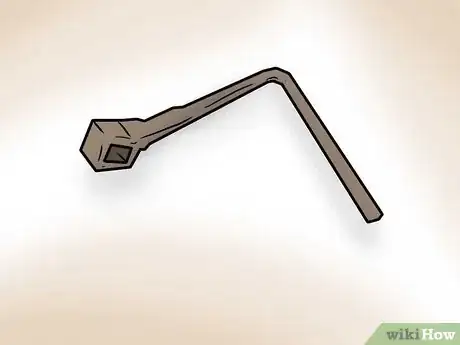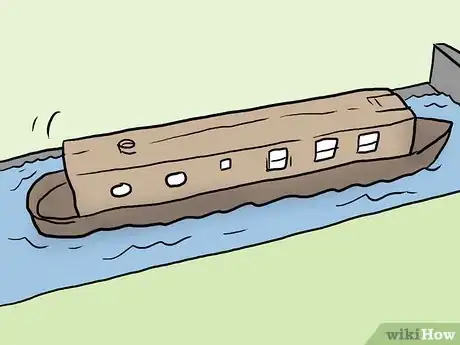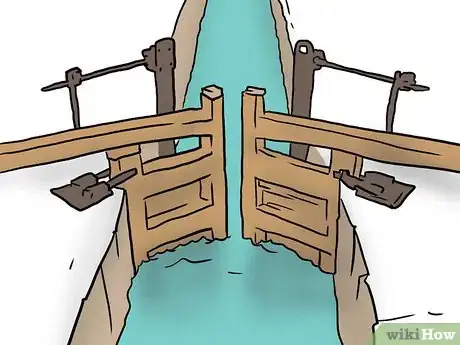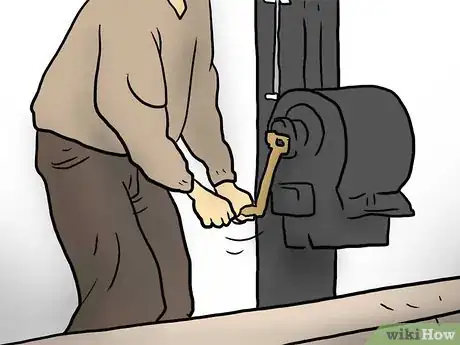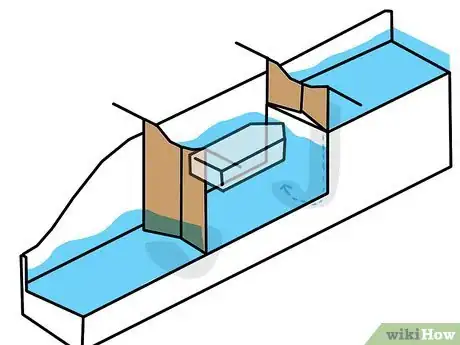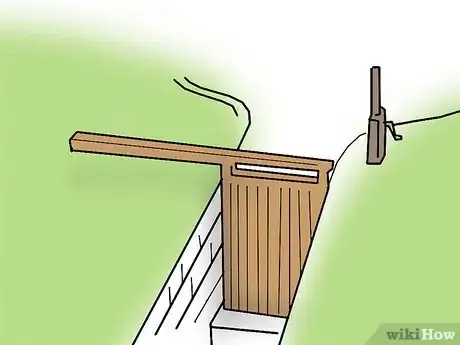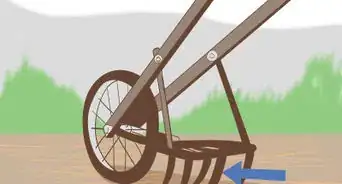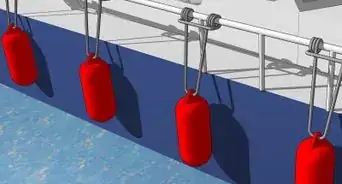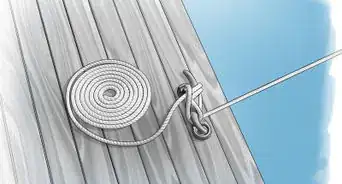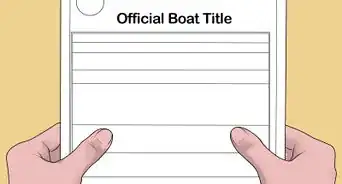X
wikiHow is a “wiki,” similar to Wikipedia, which means that many of our articles are co-written by multiple authors. To create this article, 17 people, some anonymous, worked to edit and improve it over time.
This article has been viewed 40,778 times.
Learn more...
Canals are one of the nicest things to come across in the countryside combining water, gadgets, engines and scenic views. Locks are an integral part of canal and river networks.
Steps
-
1As you approach the lock:
- Skipper - Drop off your shore crew, asking them to close the front doors of the boat. If the gates at your end of the lock are open, go straight into the lock; otherwise, moor up on the lock moorings and wait for the shore crew to open the gates.
- Lock Crew - Walk to the lock side - not forgetting an L-shaped windlass ("lock key") for everyone. Read the lock notices for any special instructions (if a lock keeper is present ask him or her)
-
2Set the lock. The lock crew needs to set the lock. If the water in the lock is not (exactly) level with the stretch of canal that the boat is in, you will need to equalise the water levels. (If the lock is set for an approaching boat - allow them to use the lock first). Make sure the gates and paddles at the far end of the lock are closed, then open the paddles at the near end (the end nearest your moored boat). You open a paddle by fitting the lock key onto the winding mechanism, and turning it many times.Advertisement
-
3The lock crew opens the gates. While the boat is entering, close the paddles.
-
4Guide your vessel into the lock. The skipper should enter the lock. If appropriate, throw a rope to your shore crew. For instance, a narrow boat ascending a wide lock can experience a lot of turbulence and you may wish to ask for your front or centre rope to be tied to a bollard, to give you something to drive against to keep position more easily. Otherwise, the shore crew will be able to control the boat without tying up, by holding the ropes and using bollards to safely reduce the strain and resist snatching - in fact if you are descending you must not let anyone tie up your craft. When descending a narrow lock there will be little turbulence and ropes are rarely needed: the skipper can usually control the boat adequately with the engine on low revs (on the River Thames, engines must be turned off in locks).
-
5Close the gate behind the boat, and check the paddles are shut.
-
6Open the paddles at the other end of the lock. Open just one paddle very slowly at first AND observe the consequences. Be ready to close paddles quickly if things start to go wrong, do not re-secure any locks on the paddles until the boat is safely ready to leave.
- When ascending: Open ground paddles first, do not open gate paddles until the lock is half full and there is no danger of a fountain of water swamping the boat (many lock gates now have baffles over the paddles to prevent this). In a wide lock, first open the ground paddle on the same side as the boat - this will usually establish a water flow that will keep the boat neatly against the lock side s it ascends (but there will be exceptions to this rule depending on the exact configuration of the lock). Be ready to close the paddles quickly if any part of the boat appears to be caught under an obstruction (particularly any foot boards overhanging the lower gate).
- When descending: Do not tie the ropes. Be ready to close the paddles again if the boat appears to be "hung up" on anything - especially the underwater cill (step) just in front of the top gates.
- Skipper - Ascending or Descending: Be ready to shout a warning to the lock crew if anything goes wrong. Keep the boat as still as possible by using a moderate amount of throttle - this will be all that is required unless you let your attention wander and let appreciable forward or backward momentum build up. Constantly check that the boat is not caught on anything by checking that a) Small touches of throttle move the boat backwards and forwards freely b) The boat is completely level c) The boat is rising or falling smoothly (measure progress by looking at the brickwork joints).
- Skipper - Ascending: Check constantly that you, the tiller, and the stern rails remain well clear of anything overhanging the bottom gate (particularly the foot boards or bridge) but also that you are not so far forward that any water leaking through or spilling over the top gates (or coming through gate paddles opened too early) is filling the front of the boat. If you have allowed passengers to remain in the front well of the boat, they may discover why a leaking lock gate is called a "Granny-Soaker". If you ever do fill the front of the boat, you will always close the front doors henceforth! If the shore crew have tied the centre or front rope in the right place, a little constant forward throttle will maintain a gentle tension on the rope which will keep the front of the boat from swinging about, leaving you free to use the rudder to keep the back of the boat neatly against the lock side.
- Skipper - Descending: There will be little turbulence when descending, though there there may be a significant backward or forward "draw". But you will probably require only light throttle touches to keep the boat stationary. BUT be absolutely certain that the rudder and propeller remain well forward of the top gate and thus are clearing the underwater sill (step): observe the white lines painted on the lock side. "Hanging" the rear of the boat on the cill as the lock continues to empty will at least damage the rudder and propeller, and is likely to sink the boat. Once caught, the only remedy is to get the lock crew to immediately close the bottom paddles (to stop the lock emptying further), and then (provided the boat is still floating, but not otherwise) to very slowly open the top paddles and refill the lock). If this is not done quickly, then as the front of the boat dips steeper and steeper, the boat will eventually slide off the cill and either drop flat into the water causing a wave that descends to swamp the boat, or simply nosedive under.
-
7Exit the lock. Once the water level has equalized you can open the gates to let the skipper steer out of the lock. While this is happening, close the paddles to preserve water and provide less work for the next boat crew. (If on your own in narrow boat in a wide lock, tie your boat while you open the gates.)
-
8Guide your vessel out of the lock and steer alongside the bank at a place where the lock crew can re-board, or simply wait in the lock exit.
-
9Close the gates - unless a boat is approaching the lock from ahead, you can save them and you time by leaving the gates open for them: if the other boat is lightly-crewed, you might even wait to close the gates after the other boat has entered. If a boat is coming from behind, you may wish to save them some time by opening a paddle at their end of the lock. Rejoin your boat.
Advertisement
Warnings
- Never tie a boat while descending - a taut rope is impossible to undo, and the boat will hang up on the ropes (at least for a while). Similarly ensure that even untied ropes cannot snag in a crack or on a protrusion.⧼thumbs_response⧽
- Keep an eye on children and pets, neither have a good enough judgment of danger around locks.⧼thumbs_response⧽
- Do NOT leave the windlass attached to the lock mechanism - if the paddle slips, the handle will fly off at lethal speed, and either kill someone or sink in the lock.⧼thumbs_response⧽
- The boat can also hang up on other protrusions.⧼thumbs_response⧽
- When descending, a common cause of problems is the cill, a concrete lip protruding into the lock chamber from the base of the upper canal. It is visible only when the water is low, but its position is usually marked by a white line on the lock side near the uphill gate. Stay forward of this line, or the rudder or propeller will be ruined, and the boat may hang up as the water falls, then possibly slide off and sink.⧼thumbs_response⧽
- When in charge of the paddles, with a boat is in the lock, stay near the paddles ready to drop them quickly. Keep an eye open for signals from the skipper. If the boat is ascending, beware particularly of flooding the front of the boat (especially with gate paddles), the skipper cannot see this.⧼thumbs_response⧽
- Locks are dangerous, never under any circumstances should you swim in one. The pressure generated by a lock can cause severe injury or kill.⧼thumbs_response⧽
Advertisement
Things You'll Need
- Windlass(es)
- life jackets (for kids)
- Mooring ropes
- A boat
- In Britain, in areas prone to vandalism, some lock paddles are fitted with "water conservation locks" (where "lock" has the normal non-canal meaning)". To undo these "locks" you will either need the usual "British Waterways" (Yale) key, or a special "handcuff" key.
About This Article
Advertisement


